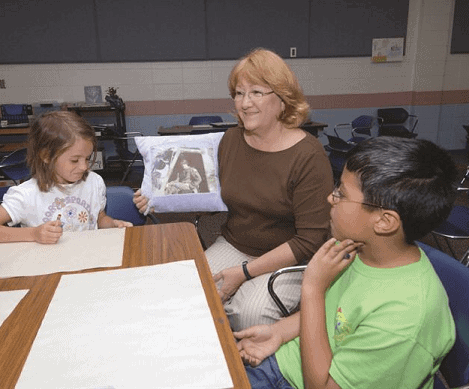How Can School Counselors & Teachers Join Forces to Promote Social-Emotional Learning?

|
Getting your Trinity Audio player ready...
|
In addition to academics, school is a prime environment for teaching social-emotional learning (SEL).
In recent years, the Every Student Succeeds Act has called attention to this need. This act requires that states measure school success with at least one non-academic indicator, such as communication, empathy, or conflict management.
In order to effectively teach children important developmental social and emotional skills, it is necessary for the teacher and the school counselor to work in an integrated way.
What is social-emotional learning?
Social and emotional learning is the process of developing and using skills to identify and regulate emotions, develop positive relationships, and make responsible decisions.
Students with social and emotional skills are more likely to showcase positive social behaviors such as sharing, empathy, and kindness.
They are also more likely to have a stronger growth mindset (the idea that positive traits, such as intelligence, can be developed with practice) and show greater resiliency.
According to the Collaboration for Academic, Social, and Emotional Learning (CASEL), Social and emotional learning development encourages the following five core competencies:
- Self-Awareness: Becoming self-aware by recognizing one’s own feelings, personal goals, strengths, and limitations on how they influence their behavior.
- Self-Management and Emotion Regulation: Learning to regulate daily stressors and manage self-emotions. This includes self-discipline, self-motivation, and impulse control.
- Social Awareness: Improving social development and awareness of others in the form of empathy and learning to appreciate cultural and social differences.
- Relationship and Social Skills: Developing the necessary social skills to create lasting and meaningful relationships with individuals and groups different from self. This includes developing communication and teamwork skills.
- Responsible Decision Making: Learning to make decisions when dealing with everyday problems, while also considering ethics, safety concerns, and everyday social norms.
What is a teacher’s role in social-emotional learning?
Teachers spend the majority of the school day with the students. They can directly influence SEL development in the classroom at every grade level.
SEL is important and shows the best results when learning opportunities occur early and continue throughout high school education. Teachers can implement the following SEL practices.

- Get to know students by name
- Start each day with a feelings check-in
- End each day with a feelings-check-out
- Set clear expectations and classroom guidelines
- Allow students to solve problems by asking them questions
- Encourage teamwork within the classroom
- Be understanding and compassionate about cultural and social differences
- Create opportunities for students to find their voice
- Model social and emotional skills
- Develop SEL interactions with students through positive relationships
- Be consistent with teaching SEL methods
Check out this video for examples of feelings check-ins and more social-emotional development.
You may also be interested in learning about an online doctorate in educational leadership.
What is a school counselor’s role in social-emotional learning?
- Assisting teachers with curriculum changes that are more in line with SEL development
- Modeling the SEL core competencies in all interactions
- Promoting alternative thinking strategies (PATHS) training of teachers (PATHS Training LLC is the original authorized worldwide provider of training and technical assistance for the PATHS curriculum, the research-based social and emotional learning (SEL) curricula for children in preschool through grade 6.)
- Providing direct instruction to academic staff (directly teaching staff methods for incorporating SEL into their classrooms and everyday interactions)
- Advocating for SEL, collaborating with school staff on programs and teaching methods, and promoting systemic change in the school
- Encouraging small group work lessons in the classroom
- Using data to demonstrate the value of SEL development
- Beginning individual and group interactions with students with a feelings check-in
- Supporting and guiding all school professionals to implement SEL in their school

What is the impact of social-emotional learning on students?
Schools that implement an SEL program are likely to see a long-term impact and positive results.
Schools often see improvements in students in the areas of academic success and behavioral and attitude development.
These positive results are expected to influence later academic success and future relationships, even after the student has left school.
A recent study by CASEL, Promoting Positive Youth Development Through School-based Social and Emotional Learning Interventions, finds that students increase as much as 13 percentile points academically, on average, approximately 3.5 years after being exposed to an SEL academic program.
CASEL’s study also found that students had significantly decreased rates of emotional and conduct problems, drug use, and an increase in both social and developmental skills.
In Early Social-Emotional Functioning and Public Health, a study published by the American Public Health Association, students exposed to SEL in a kindergarten program were more likely to have improved educational and employment success, as well as lower substance abuse and fewer occurrences of mental health problems.
More schools are learning of the advantages of an SEL academic program and are increasingly implementing these curriculum changes and additions.
Students are left with improved social and problem-solving skills. The collaboration of teachers, school counselors, and other school personnel to implement an SEL model of development, leads to higher overall success rates for students and the school.
EDUCATIONANDBEHAVIOR.COM – Keeping adults on the same page for kids!
This post is sponsored by Spalding University. Sponsors allow us to keep providing resources and materials to help children in academic need.







